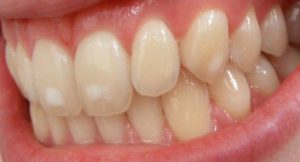Teeth can be lost in a number of ways, namely, tooth decay, gum disease, infection, trauma, and failed restorative dentistry.
Tooth decay is sadly a very common occurrence of tooth loss.
The process of a tooth decaying, means that the sugar present in the diet, has been processed by the bacteria present in the mouth and the result of that process is the production of a certain type of acid. This acid slowly eats away at and softens the teeth.
When a dentist examines your teeth, they are looking for early signs of this decay, so that the decay can be removed and a simple filling placed to restore the tooth tissue lost from the decay.
However, it may be that someone hasn’t been to the dentist in a very long time and that decay has gone undetected. If that is the case the removal of the decay and successful restoration of the tooth may not be possible. Under these circumstances, the dentist would have to remove the tooth to prevent further potential complications mainly an infection of the tissues around the tooth.
Gum disease is the most common cause of tooth loss today. We all have plaque in our mouth, which is a very complex substance made up of bacteria and other substances.
It isn’t easy to detect with the human eye, but it grows 24/7 in our mouth, 360 degrees around every tooth and gum surface in our mouth.
If left long enough, minerals in our saliva turn that plaque into tartar or calculus, which further gathers plaque and a vicious circle starts up. That plaque can quite easily affect the gum health around the teeth.
For more information, please click here to email the practice to make an appointment or call 01202 973300.
The result of that can be the development of gum disease.
The ultimate result of gum disease is the gradual loss of the bone which supports the teeth and keeps them stable in the jawbone. If that bone loss gets severe enough, the teeth can become loose and/or get infections around them, resulting in the teeth being shed or having to be removed by the dentist.
Infection of a tooth can happen generally in one of two ways. Either, the blood supply inside the tooth known as the pulp can die, or the gum tissue around the tooth can become severely inflamed and diseased. The pulp can die as a result of decay, multiple fillings and or crowns or trauma.
The process whereby an infection happens is rather a complex one, but to take it to its very basic level, if there is some dead or necrotic tissue in the body, the body’s natural immune system cannot reach that area.
It, therefore, cannot fight off bacteria in the normal fashion, and that inability to fight off bacteria leads to a complex reaction known as an infection or abscess.
We have treatments available to us to treat the causes of the infection but these may not be successful and the tooth or teeth may have to be removed.
 Trauma to the teeth refers to anything that has unduly impacted the teeth resulting in them either being broken or even avulsed ( knocked out ). The most common causes of trauma to the teeth are sporting injuries, assault, falls, external impact ( often from puppies jumping up or the occasional baby headbutt ! ), road traffic accidents or anything you can think of that might result in an impact to the face and teeth.
Trauma to the teeth refers to anything that has unduly impacted the teeth resulting in them either being broken or even avulsed ( knocked out ). The most common causes of trauma to the teeth are sporting injuries, assault, falls, external impact ( often from puppies jumping up or the occasional baby headbutt ! ), road traffic accidents or anything you can think of that might result in an impact to the face and teeth.
A lot of these causes are of course accidental, but sporting injury trauma to the teeth can be avoided by the use of a high-quality mouth protector ( or gum shield ). If the teeth are broken beyond restoration they may need to be removed.
Evulsed teeth may sometimes be put back into place if the patient is seen very early.
While they may not last for the rest of your life, they may be still in place and causing no further problems many years later.
Teeth may also be lost due to failed restorative dentistry.
Even though a dentist or multiple dentists may have carried out very high standard restorative work on your teeth such as fillings, crowns or bridges, it all has a shelf life and at some point the tooth may break and not be able to be repaired or restored, meaning it would have to be removed.
The most common failure in restorative dentistry is a post crown.
A post crown is when a dentist has placed a small, often metal post or pin inside your tooth, which is used to support restorative material which is then crowned.
As you can imagine, the tooth at this point will have had a lot of work carried out on it and is never as strong as nature designed it to be. Teeth with post crowns often fracture beyond repair and ultimately have to be removed.
